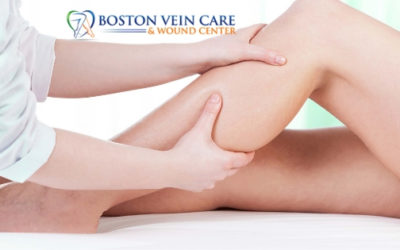Let’s discuss some complications of varicose veins on legs:
Superficial Vein Thrombosis (SVT)
The pooling of blood in varicose veins on legs can cause stagnant blood flow, causing blood to clot in the insufficient veins. A blood clot also called a thrombus, is blood that has coagulated or clotted. This condition is called superficial venous thrombosis and as long as it stays in varicose veins (which are superficial veins), it does not pose a significant risk. Sometimes it can be associated with phlebitis, causing pain and redness in the area of superficial venous thrombosis.
Deep Vein Thrombosis (DVT)
In the majority of patients who develop blood clots, it starts in deep veins on legs but in a smaller subset of patients the clots develop in superficial veins but extend to deep veins. The risk of both superficial venous thrombosis and deep venous thrombosis increases with varicose veins. Deep vein thrombosis(DVT) is a medical emergency which requires immediate medical attention and treatment. The most common complaints of deep venous thrombosis are legs swelling, redness and pain. The main concern in DVT patients is the risk that part or all of the blood clot may break off and move towards the lungs, causing a life-threatening condition called pulmonary embolism.
Thrombophlebitis
It is an inflammatory process involving superficial veins. The symptoms of thrombophlebitis are mostly redness and pain and sometimes fever. Symptoms of thrombophlebitis are similar to symptoms of cellulitis. It can be a stand-alone condition but may be associated with a blood clot which can block one or more veins.
Lipodermatosclerosis
Lipodermatosclerosis refers to changes in the skin of the lower legs after a long history of varicose veins. It is a form of inflammation of the layer of fat under the skin. Signs and symptoms are a pain, hardening of the skin, change in skin color (gray or brown discoloration), and swelling.
Venous ulcers
Venous ulcers are also known as stasis ulcers are usually end result of untreated varicose veins. The underlying cause of this condition is venous insufficiency or malfunctioning of venous valves. Inlay term, it is commonly known as “leaky veins” increasing pressure in the veins which causes leakage of proteins in the tissue under the skin which initiates an inflammatory response and eventually wounds. Venous ulcers typically occur along the inner or outer distal calf and around ankles. This is a very painful and a scary condition by patients and can be avoided by newer non-surgical and minimally invasive vein on legs treatments in Boston Vein Care with offices in Boston MA, Wellesley MA, and Lowell MA.

